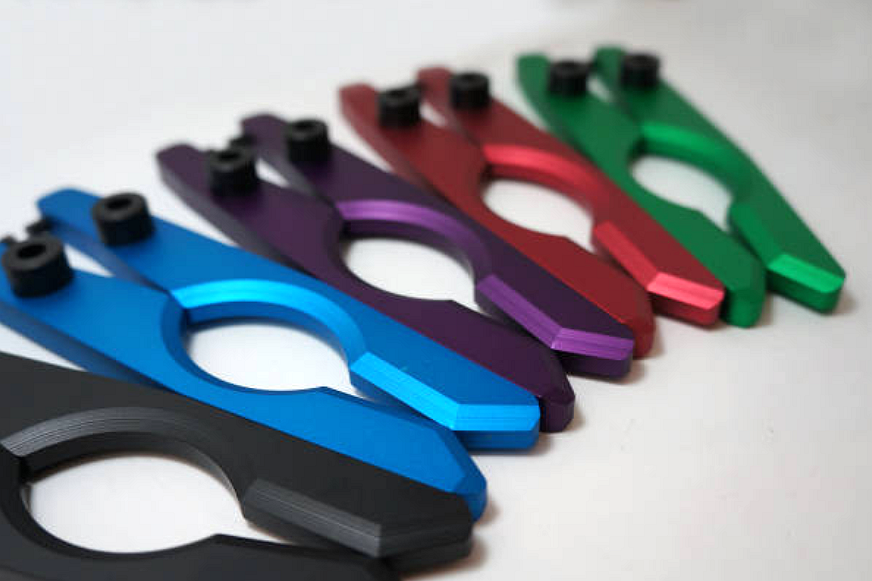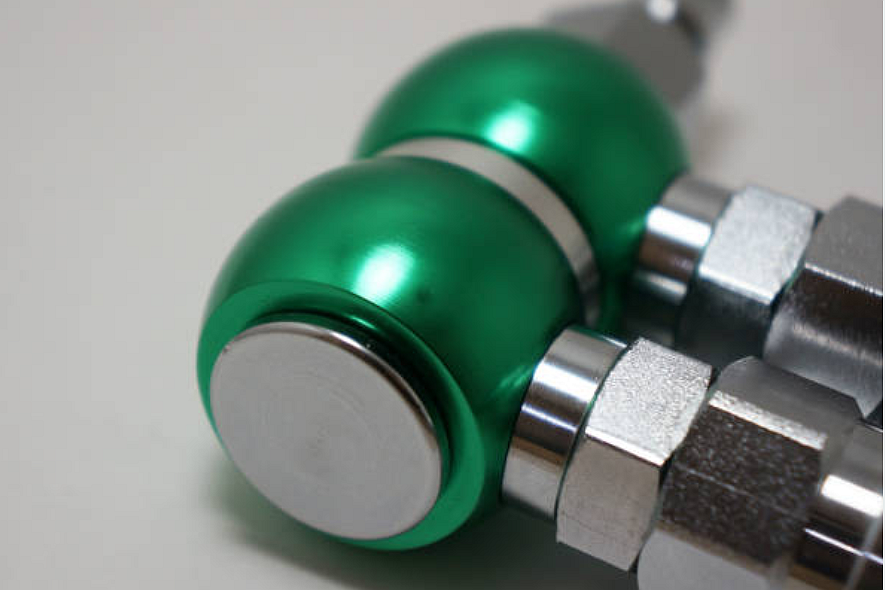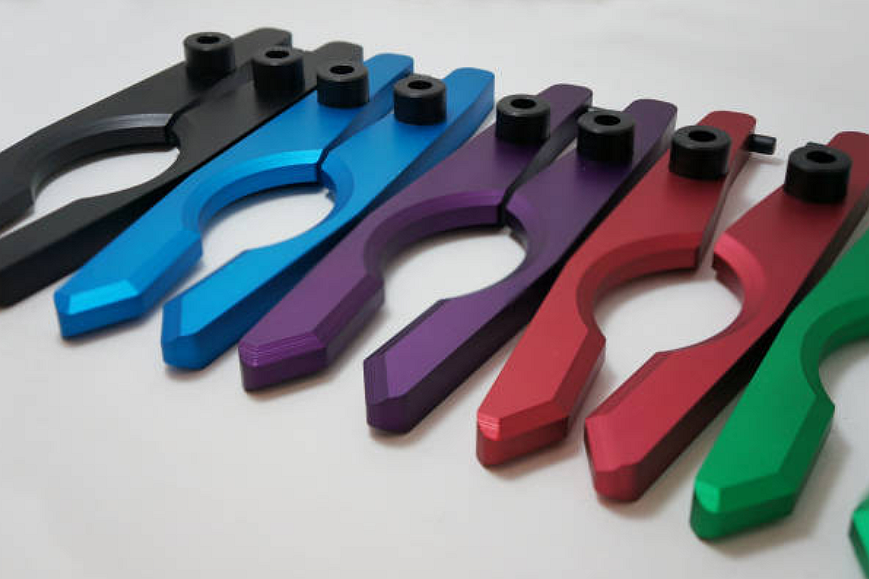Anodized Aluminum Parts: Exploring the Anodizing Process and Benefits
Overview of Aluminum as a Versatile Material
Aluminum is an incredibly versatile material that finds widespread use across various industries. Its lightweight nature, excellent surface finishing properties, and excellent corrosion resistance make it a popular choice for numerous applications. To further enhance its properties, aluminum can undergo a process called anodizing. In this article, we will explore the concept of aluminum anodizing in detail, covering its definition, classification, key characteristics, anodizing parameters, advantages, limitations, applications, and maintenance.

Definition and explanation of the anodizing process
Anodizing aluminum involves an electrochemical process that creates a protective layer on the surface of the metal. This process is typically carried out in a sulfuric acid electrolyte, where aluminum acts as the anode. An oxide layer is formed by applying an electric current, which offers several benefits, such as increased corrosion resistance and improved durability. The anodized coating thickness is a critical factor in determining the performance of the anodized aluminum.
Classification of anodizing aluminum
Anodizing aluminum can be classified into different types, depending on the anodizing process and the resulting coating properties. Some commonly known types include
Type I: sulfuric acid anodizing
We commonly use sulfuric acid anodizing. Its advantage is its high-cost performance. It is cheap to produce and easy to handle. Generally, factories can get started with sulfuric acid anodizing after simple training. However, because the current of sulfuric acid anodic oxidation is low, the film on the surface is not very stable, so other processing steps are needed to stabilize the oxide film. Moreover, the sulfuric acid oxide film is a colorless and transparent oxide film with high hardness and good wear resistance—strong adsorption capacity and easy to dye and seal.
Advantages
The sulfuric acid oxidation tank solution has simple components, stable performance, a wide range of acceptable impurity content, a simple oxidation process, a short time, and easy operation. Disadvantages: Complex parts are prone to local over-corrosion.
Type II: chromic acid anodizing
The oxide film of chromic acid oxidation is gray to dark gray or iridescent, and the oxide film is much thicker than that of sulfuric acid oxidation. The film layer is softer and more elastic than the sulfuric acid film, but its wear resistance is worse than that of the sulfuric acid film, and it is not easy to be dyed, incredibly not easy to be dyed black. The chromic acid oxide film is a good base layer suitable for painting. Chromic acid oxidation is suitable for processing aluminum parts that require small dimensional tolerances and high flatness. Disadvantages: The cost and power consumption of chromic acid oxidation tanks are higher than sulfuric acid oxidation tanks.
Advantages
The chromic acid anodizing process formula is formulated from a single chromic anhydride, a relatively traditional process.

The oxide film obtained by chromic acid anodic oxidation is thinner than sulfuric acid anodized film. Generally, only 3-59m, and the wear resistance of the film layer is not as good as that of sulfuric acid anodized film, but the film is thin. It will not affect the assembly of precision parts, and It can maintain the original's precision and has good elasticity.
The appearance of chromic acid anodic oxidation film varies with the composition of the substrate, and the appearance color is opaque off-white to dark gray. Its color is natural, similar to plastic products, and has a porcelain texture and specific decorative properties. However, the porosity of the film is low, and it is unsuitable for dyeing, so it can be used without sealing. The bonding strength between the chromic acid anodized film and the organic coating is firm, and it is not only an excellent bottom layer of the paint but also widely used as a rubber adhesive.
The chromic acid anodizing electrolyte has a low solubility for aluminum. If the electrolyte remains in blind holes and slits, it has little effect on the corrosion of parts, so it is suitable for castings, riveting, and welding parts. When choosing this process method to anodize aluminum and its alloys, the characteristics and scope of application of this process should be fully considered. It is unsuitable to use this process when the substrate contains high components such as copper and silicon; otherwise, the quality of the film layer could be better, and the anodizing electrolyte will also be polluted.
The chromic acid anodizing process is mainly used in aviation and aerospace products, and there are relatively few general industrial applications.
Type III: hard coat anodizing
Each type has distinct characteristics that make it suitable for specific applications. Different anodizing processes can be applied to enhance the performance and appearance of cast aluminum parts.
The critical characteristics of anodized aluminum include enhanced corrosion resistance, increased hardness, and improved dyeing ability. The anodized aluminum parts benefit from anodizing as it significantly improves their resistance to environmental factors and wear. Depending on the desired outcome, the oxide layer formed during anodizing can be porous or nonporous. Porous anodized coatings allow for dyeing, providing a wide range of anodized aluminum colors. On the other hand, nonporous coatings are primarily used in applications where corrosion resistance is the primary concern.
Difference between hard anodizing and ordinary anodizing
1. Concentration difference: general oxidation is about 20%; complex oxidation is generally 15% or lower.
2. The temperature is different: ordinary oxidation is about 18-22 °C, which can reach 30 °C with additives. If the temperature is too high, powder or cracks will quickly appear; complex oxidation is generally below five °C. The lower the temperature, the higher the hardness.
3. Current/voltage difference: general oxidation current density: 1-1.5A/dm2; complex oxidation: general oxidation voltage ≤ 18V, hard oxidation sometimes as high as 120V.
Second, the difference in film performance:
1. The applicable occasions are different: ordinary oxidation is mainly suitable for decoration, while complex oxidation is mainly for function and is generally used in wear-resistant and electric-resistant occasions. These are the more performance comparisons we usually use, and many other differences exist.
2. Surface state: the ordinary oxidized surface is relatively smooth, while the hard oxidized surface is rough (microcosmic, related to the surface roughness of the substrate).
3. Different porosity: typical oxidation porosity is high; stiff oxidation porosity is low.
4. Thickness of the film layer: the thickness of the ordinary oxide film layer is relatively thin; the thickness of the complex oxide film layer is generally > 15 μm, which is too low to meet the requirement of hardness ≥ 300HV.
5. Ordinary oxidation is a transparent film; hard oxidation is an opaque film due to the thickness of the film.
Anodizing Parameters and Variables
Several parameters and variables play a crucial role in the anodizing process and influence the quality of the final product. Voltage and current density are essential factors that determine the thickness of the anodized coating. Higher voltages and current densities result in thicker coatings, while lower values produce thinner coatings. The anodized coating thickness can be carefully controlled by adjusting these parameters.
Anodizing time and temperature are also significant variables. Longer anodizing times and higher temperatures contribute to the growth of a thicker oxide layer. The choice of time and temperature is based on the desired coating thickness and the application's specific requirements.
Customizing the appearance of anodized aluminum is another advantage of the process. Anodizing color options are plentiful, with a vast array of hues available for selection. Manufacturers can create visually appealing products that suit customers' preferences by dyeing the porous oxide layer. An anodizing company specializing in customization can provide various colors and finishes to meet specific design requirements.
Sealing the anodized coating is another important consideration. It helps enhance the corrosion resistance and durability of the aluminum. Various sealing options are available, including hot water and nickel acetate sealing. Choosing the appropriate sealing method depends on the specific requirements and desired outcome.
Advantages and Limitations of Aluminum Anodizing
Aluminum anodizing Advantages
Corrosion Resistance
Anodized aluminum exhibits enhanced corrosion resistance, making it suitable for outdoor applications and harsh environments. This quality is precious for applications where the material is exposed to moisture, salt, or other corrosive elements. The enhanced corrosion resistance ensures that the anodized metals remain structurally sound and visually appealing over an extended period.
The aluminum or its alloys of the anode are oxidized, and a thin layer of aluminum oxide is formed on the surface, the thickness of which is 5-30 microns, and the hard anodic oxide film can reach 25-150 microns. Enhanced corrosion resistance, no corrosion after thousands of hours in ω=0.03NaCl salt spray
Wear Resistance
The anodizing process increases the hardness of the aluminum surface, making it more resistant to scratches and abrasions. This property is especially crucial for applications where the material is subjected to constant use and potential mechanical stress. Anodizing cast aluminum parts can significantly improve their lifespan and performance, especially in environments with high levels of wear and tear.
Anodized aluminum or its alloys improve its hardness and wear resistance up to 250-500 kg/mm2, good heat resistance, hard anodized film melting point of up to 2320K, excellent insulation, and impact resistance. The breakdown voltage is as high as 2000V, and there are a large number of micropores in the oxide film thin layer, which can absorb various lubricants, and is suitable for manufacturing engine cylinders or other wear-resistant parts.
Aesthetic customization Options
The aluminum oxide film has a strong micropore adsorption capacity and can be colored into various beautiful and bright colors. Non-ferrous metals or their alloys (such as aluminum, magnesium, and their alloys, Etc.) can be anodized. With the ability to dye the porous oxide layer, manufacturers can create products in various colors and finishes. This feature is particularly appealing in architecture, consumer products, and electronics industries, where visual appeal plays a significant role. Companies that offer anodized plating services can provide customized finishes that align with specific design preferences.

Anodizing Limitations
Despite its many advantages, aluminum anodizing does have limitations. Over time, anodized aluminum may experience color fading due to prolonged exposure to UV radiation. This is particularly relevant in outdoor applications where the material is subjected to direct sunlight. However, advancements in dye technology and the use of UV-resistant coatings have mitigated this issue to a large extent.
Anodized aluminum surfaces are also susceptible to scratches and abrasions. While the anodized coating significantly improves the material's resistance to wear, it is not impervious to physical damage. Care should be taken to avoid contact with sharp objects and abrasive surfaces to maintain the integrity of the coating. Regular maintenance and appropriate cleaning techniques can help preserve the appearance and performance of anodized aluminum parts.
Maintenance and Care of Anodized Aluminum
Proper maintenance and care are essential to ensure anodized aluminum's longevity and optimal performance. Cleaning techniques and precautions should be followed to prevent damage to the anodized coating. Mild soap, water, and non-abrasive cleaning tools should be used for routine cleaning. Harsh chemicals and abrasive materials should be avoided as they can scratch or damage the coating. Regular cleaning will help maintain the aluminum's appearance and anodized coating thickness.
Protecting anodized surfaces from damage is crucial. It is essential to avoid contact with sharp objects and abrasive surfaces that can cause scratches and abrasions. Protective coatings or films can minimize color fading in areas with high UV exposure and protect the anodized coating from degradation over time. Proper precautions should be taken to preserve anodized aluminum's aesthetic appeal and performance.
Restoration and repair are possible in the event of damaged anodized coatings. Anodized aluminum can be recoated or stripped and re-anodized, depending on the extent of the damage. Seeking professional services from an anodizing company specializing in restoration can provide effective solutions for repairing damaged coatings and ensuring the longevity of anodized aluminum products.
Anodizing cost is influenced by various factors, such as the size and complexity of the part, the desired coating thickness, the anodizing process used, and the customization options required. More significant and intricate parts may require more resources and time, increasing costs. However, the benefits of anodizing, including enhanced corrosion resistance, improved durability, and aesthetic customization, often outweigh the associated costs.
In conclusion, aluminum anodizing is a highly effective process that enhances aluminum's performance, durability, and aesthetic appeal. By forming a protective oxide layer, anodized aluminum gains increased corrosion resistance, improved hardness, and customizable colors. It finds applications in architecture, automotive, consumer products, and aerospace industries. Proper maintenance and care are crucial to preserving the appearance and performance of anodized aluminum. By following recommended cleaning techniques, protecting the surfaces from damage, and seeking professional assistance for restoration, the longevity and benefits of anodized aluminum can be maximized.
